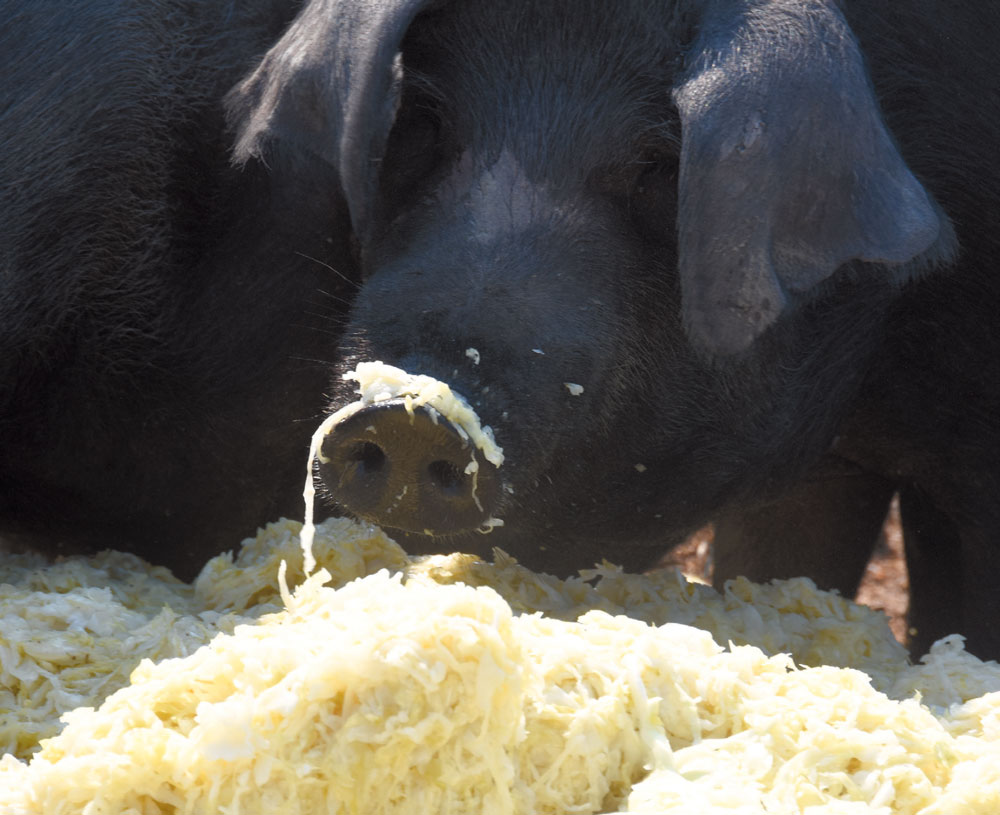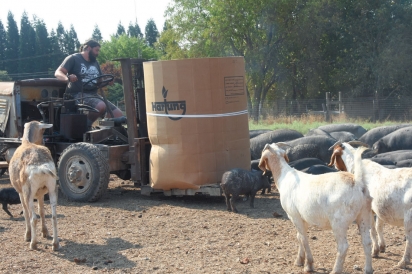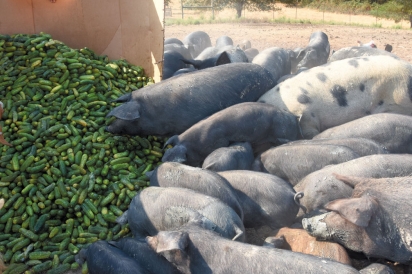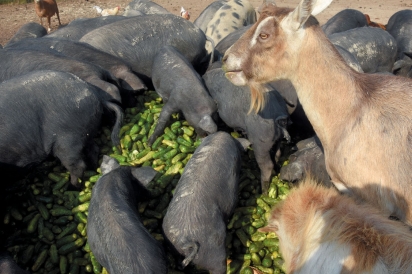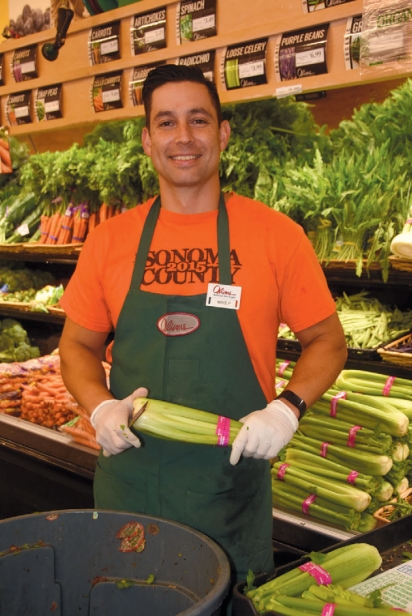Ultimate Upcycling
FROM FOOD SCRAPS TO FILET MIGNON
On a typical weekday morning, Jeff Kent hops in his flatbed truck and spends a couple of hours collecting feed for his pigs, goats, chickens and ducks. He is gathering food that otherwise would be bound for the trash bins at Alive and Healing Tempeh, Costeaux French Bakery, Oliver’s Market and TierraVegetables—all within a few miles of his Windsor farm.
After filling his truck with a half-ton of high-quality food “waste,” Kent heads back home to Takenoko Farms, where he drives straight to the back pastures. The goats, birds and pigs come running from every direction to gobble up the food.
All of Kent and business partner Jeremy Gotelli’s animals are fed on restaurant and food production scraps from these and other food and drink producers in the area. “We literally buy no commercial feed,” Kent says.
Takenoko Farms, like a handful of other small farms in Sonoma County, is continuing—or, rather, reviving—the time-honored tradition of feeding livestock, especially pigs and chickens, the discards and excess generated by the human food system. The time-consuming practice of gathering discards from grocers, restaurants and breweries fell out of favor when animal farming became industrialized in the 20th century. It is much faster and easier to fill rows and rows of troughs from bags of processed feed. But there are consequences—to the animals, and to the environment.
According to a study published in 2013 in the journal Environmental Research Letters, “Currently, 35% of the calories produced by the world’s crops are being used for animal feed.” Emily S. Cassidy and her co-authors of the study propose that, “given the current mix of crop uses, growing food exclusively for direct human consumption could, in principle, increase available food calories by as much as 70%, which could feed an additional four billion people (more than the projected two to three billion people arriving through population growth).” It follows, then, that one significant way to free up more cropland for the direct feeding of the human population is to stop using it for animal feed production and direct the tremendous amount of waste generated by the human food system to the feeding of these livestock animals instead.
And it is a tremendous amount. According to a report published in 2012 by the Natural Resources Defense Council (NRDC), up to 40% of food produced in the United States ends up in landfills. And it gets even worse: The study also found that “Almost all of that uneaten food ends up rotting in landfills where organic matter accounts for 16% of U.S. methane emissions.” The author of the report, Dana Gunders, a staff scientist with the NRDC, states, “If food waste were a country, it would rate third in greenhouse gas emissions.”
Scientists also report that methane has 25-fold more potent global warming potential than CO2, the primary end product of food eaten and metabolized by humans. And by animals, as well.
By feeding food “waste” to animals, we can both free up arable land and drastically reduce methane emissions. It seems both an obvious and a simple solution.
Oliver’s Markets, a group of four grocery stores in Sonoma County, donates its discarded produce to local farms on a daily basis. Mike Peterson, Oliver’s produce coordinator, understands the valuable role that grocery stores can play. He says, “The first thing we are trying to do is create a closed loop in the food system. Food is grown for people, and if it’s not going to people, it should go to animals, and if it’s not going to animals, it should go to compost. Just completing that circle of life and knowing that it’s not going to complete waste is probably the most beneficial thing for Oliver’s, being a green-certified company. The second thing is, it does cut our cost when it comes to the compost. If we were throwing every single thing away in the compost that wasn’t going to the farms, we would probably have to get a pickup every day from the disposal company. It’s not cheap for them to pick up that compost bin.”
Peterson, who has worked for Oliver’s Markets for 18 years, was instrumental in implementing the grocer’s “formalized” food waste-to-farms program around 10 years ago. A prior policy of setting the unwanted produce out for public pickup wasn’t very successful, he tells me. “If you knew about it, you might go grab something for your chickens, but usually most of the stuff went into the compost bin.” Since they started assigning specific days and times for designated farmers to pick up discarded produce, Oliver’s has greatly reduced their produce waste, and, by Peterson’s conservative estimate, around 300–400 pounds of produce waste is being diverted to farms each day from each of their stores.
Marisa Guzman has been collecting discarded produce from Oliver’s Montecito store since 2010 for her small family farm in Western Santa Rosa. Guzman, along with her parents and sister, raises goats, chickens, turkeys and a steer. Regarding the donated produce she says, “I think it’s great, because it’s a way for it not to go to waste or end up in the landfill, and it helps me not to spend as much on feed. I am very grateful that they do that for the community.” She adds, “We get trimmings from Oliver’s, plus rinds. I’ll take anything. Chickens love the lettuce. Goats get radishes, asparagus and zucchini. The steer gets corn husks and he loves fruit. He also gets cabbage—all of that roughage. I cut up the whole melons and give those to chickens. They love the seeds, too. Blueberries, raspberries, the chickens get all that soft stuff. Whatever the animals don’t eat, we use as compost for the garden.”
The key to making the relationships work between the farmers and the grocers and food producers is consistency. Kent of Takenoko Farms says, “We also get food from Sonoma Brinery in Healdsburg and I make an effort to take everything they offer. Even if it’s too much to feed to our animals and we need to compost it ourselves, I say to them, ‘All right, I’ll make it happen.’ Just this last week we got eight tons of cucumbers and two tons of sauerkraut because they got shipped a whole batch of cucumbers that were overripe when they arrived.”
Peterson of Oliver’s agrees that it’s crucial for the farmers to be reliable. He says, “If somebody commits to a day and time, my staff does spend some time and labor protecting that produce for them, so if they don’t come, there’s a good chance that the secondary people—the people with hobby farms and backyard chickens—are never going to pick up that much produce. By the time 5 o’clock rolls around, somebody on my staff is calling me and asking, ‘What do you want me to do with this 400 pounds of produce?’ And then the compost bin would literally fill up in a day.”
Spent grain from breweries has also been a longstanding source of livestock feed. The process of making beer results in what is known as sparged, or spent, barley, which can comprise up to 85% of the total by-product of a brewery. Alcohol-free and containing very little sugar, sparge is rich in minerals, fiber and protein. It can be eaten by ruminants such as goats, cattle and sheep, as well as by monogastric omnivores like pigs and poultry.
Lagunitas Brewing Company’s brewery in Petaluma has been offering its spent barley to local farmers since the brewery opened in the early 1990s. They sell primarily to medium- and large-scale dairy farmers, but also to small farms with pigs, chickens or sheep.
“I try not to turn anyone down,” says Dean Stocker, the agricultural manager at Lagunitas, who runs their by-products distribution program. “We don’t want to put it in the dump. We support them and they support us. They do pay us, but we try to keep the price down and we’ve never raised the price. It’s good for the cattle and it’s inexpensive compared to the other commodities they could buy.”
Stocker himself raises steers on land behind Lagunitas. Those steers eat the brewery’s spent barley and they are, in turn, on the menu at Lagunitas’ on-site restaurant.
One road block to the ability of more local farms to utilize food waste, including spent grain from breweries, is that certified organic food animal operations must ensure that all of their feed is also certified organic—not so simple when receiving discarded food.
The trub from Lagunitas, however—the layer of sediment created after the yeast has completed most of the fermentation process—is a by-product that the brewery can sell as a nutritional supplement to even certified organic animal farms. “There are 10–20 local dairies using that by-product. Mostly it’s liquid they pour over organic hay—it’s high in protein,” says Stocker.
For the backyard chicken and family pet goat owners out there, don’t be discouraged by the stories of these larger-scale operations teaming up. There is plenty of opportunity here for you, too. Ask your favorite home brewer to trade their spent barley for your eggs. Talk to the produce manager at your local grocery store. Ask a restaurant for their pre-consumer food scraps. (Note: The scraps from any food that has been partially eaten by humans needs to be pasteurized before feeding to animals, due to the possibility of passing human diseases to the animals.)
Jeremy Gotelli of Takenoko Farms suggests, “For a small farm, they should just go to a restaurant near them and talk to them. Tell them, ‘Here are two five-gallon buckets, I’ll come back in two days and get the scraps.’ Then feed them to your animals. It’s gold. It’s perfect.”
Nrdc.org/resources/wasted-how-america-losing-40-percent-its-foodfarm-fork-landfill


